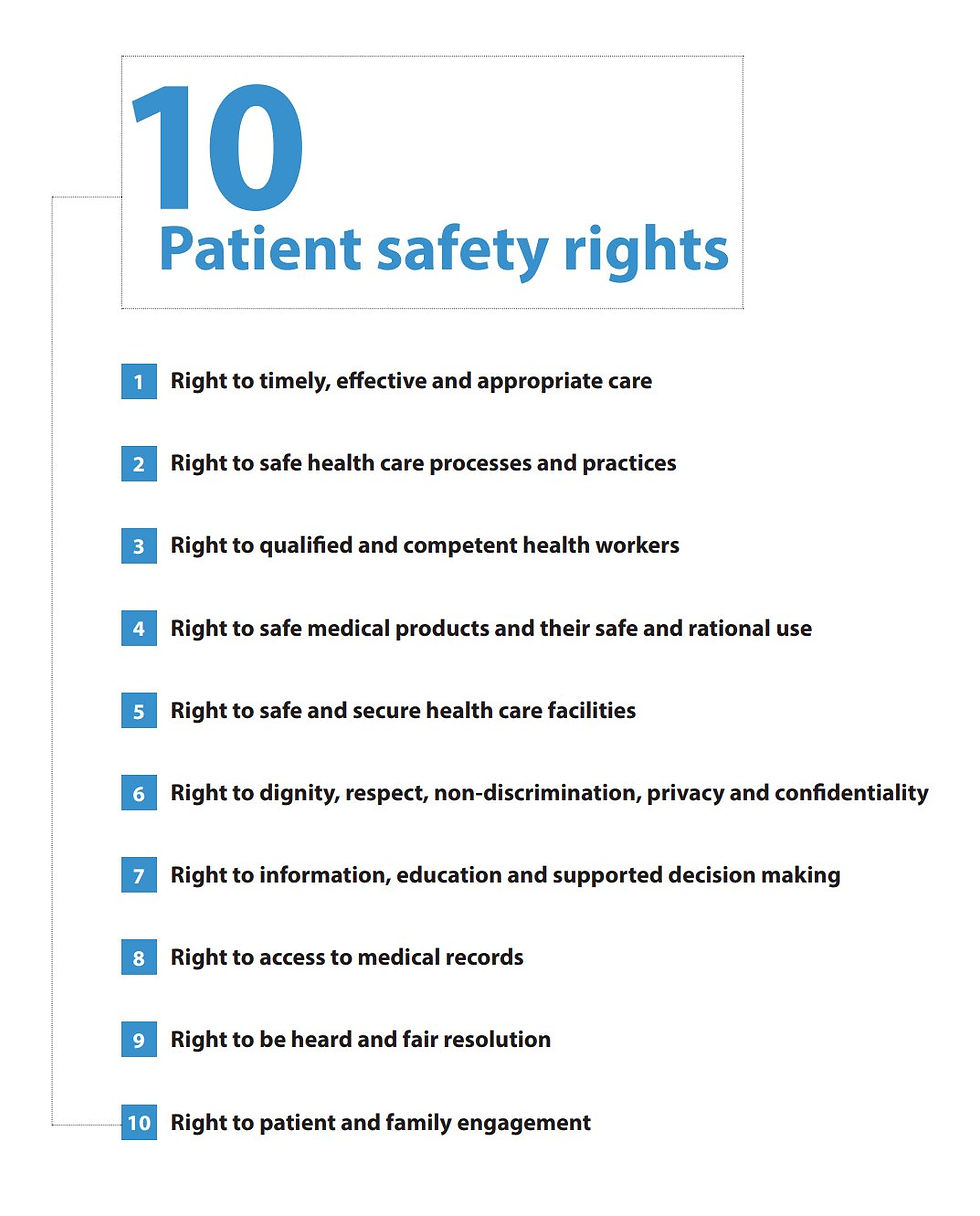The World Health Organization (WHO) launched the first-ever Patient Safety Rights Charter in April 2024 [WHO: Patient Safety Rights Charter].
This charter is a significant development aimed at empowering patients and improving healthcare safety globally.
Purpose:
Outlines 10 essential patient safety rights: These rights serve as a framework for ensuring patients receive safe and high-quality healthcare [WHO: Patient Safety Rights Charter].
Empowers patients: The charter provides patients with a clear understanding of their rights and encourages them to advocate for their safety in healthcare settings [WHO: Patient Safety Rights Charter].
Supports governments and healthcare leaders: It offers guidance for developing legislation, policies, and practices to prioritize patient safety [WHO: Patient Safety Rights Charter].
Content:
The 10 patient safety rights outlined in the charter focus on various aspects of safe healthcare:
Right to timely, effective care
Right to safe healthcare processes and practices
Right to information and communication
Right to informed consent
Right to respect for privacy and confidentiality
Right to a complaint process
Right to safety in the healthcare environment
Right to involvement in your care
Right to education about your health condition
Right to continuity of care

Benefits:
Improved patient outcomes: By promoting patient safety and engagement, the charter can lead to better healthcare experiences and reduced harm to patients.
Stronger patient-provider relationships: Increased awareness of patient rights can foster trust and collaboration between patients and healthcare providers.
More efficient healthcare systems: By focusing on preventing errors, the charter can contribute to a more efficient and cost-effective healthcare system.
The WHO's Patient Safety Rights Charter is a valuable tool for patients, healthcare providers, and policymakers. It serves as a roadmap for creating a culture of safety and empowering patients to take an active role in their healthcare.
WHO: The World Health Organization (WHO)
The World Health Organization (WHO) is a specialized agency of the United Nations responsible for international public health. Established on April 7, 1948, it is headquartered in Geneva, Switzerland.
The WHO's primary role is to direct and coordinate international health within the United Nations system.
Key Functions and Responsibilities of WHO:
Health Systems Strengthening: WHO works to improve health systems worldwide, ensuring they are efficient, equitable, and resilient. This involves providing technical support, setting norms and standards, and monitoring health trends.
Disease Prevention and Control: WHO leads global efforts to combat communicable diseases (such as HIV/AIDS, malaria, tuberculosis) and non-communicable diseases (such as cancer, heart disease, and diabetes). This includes conducting research, developing vaccines and treatments, and coordinating international responses to outbreaks.
Health Promotion: The organization promotes healthy lifestyles and environments, addressing determinants of health such as nutrition, sanitation, and mental health. It also works to reduce risk factors for diseases through education and policy advocacy.
Emergency Response: WHO plays a critical role in responding to health emergencies, including natural disasters, outbreaks of infectious diseases, and humanitarian crises. It provides leadership, coordinates international efforts, and supports affected countries with technical expertise and resources.
Setting Standards and Guidelines: WHO establishes international health standards and guidelines to ensure the safety and efficacy of medicines, vaccines, diagnostics, and other health interventions. It also develops guidelines for health practices and policies.
Health Data and Research: WHO collects and disseminates health data from around the world, providing evidence-based information to guide policy and decision-making. It conducts research to advance global health knowledge and practices.
Advocacy and Partnerships: WHO advocates for global health issues at the highest political levels and works in partnership with governments, non-governmental organizations, international agencies, and other stakeholders to achieve health goals.
Governance:
WHO is governed by the World Health Assembly, composed of representatives from its 194 member states. The Assembly meets annually to set policies, approve budgets, and elect the Director-General. The Executive Board, composed of 34 health experts, facilitates the implementation of the Assembly's decisions and advises on policy matters.
Thanks For Visiting!!

Comments